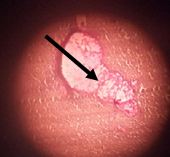Cryptococcosis infection in HIV-AIDS
Keywords:
CRYPTOCOCCOSIS, ACQUIRED IMMUNODEFICIENCY SYNDROME, MENINGITIS.Abstract
Introduction: cryptococcosis is a systemic mycosis produced by an encapsulated yeast form fungus called Cryptococcus neoformans. Most of cryptococcal infections occur in HIV / AIDS patients with advanced immunosuppression. In another type of immunosuppressed patient is less known, but it has been increasing in frequency.Objective: to present a case of cryptococcal infection in an HIV-infected immunosuppressed patient, who manifested as a generalized disease at Leon Cuervo Rubio hospital in Pinar del Rio. In this case, the infection was diagnosed postmortem and a necropsy study was performed.
Conclusions: a correct medical deliberation is required before an immunosuppressed patient for any cause, with symptoms that could correspond to a deep mycosis. Before a neurological picture in an immunocompromised patient, India ink staining should be performed to the cerebrospinal fluid to identify if there is the presence of cryptococcus. Educational work should be carried out in the community concerning the epidemiology of the disease due to the frequency of pigeon breeding in the country.
Downloads
References
1. Bonifaz Trujillo JA. Criptococosis. En: Micología Médica Básica.5ta.Ed. Cap 24. México: McGraw-Hill Global Education; 2015. p 28. Disponible en: http://accessmedicina.mhmedical.com/Content.aspx?bookId=1529§ionId=98868375
2. Perfect J, Casadevall A. Cryptococcosis. Infect Dis Clin North Am. [Internet] 2002 [Citado el 15 de mayo de 2016]; 16(4): [Aprox. 10p.]. Disponible en: https://www.ncbi.nlm.nih.gov/pubmed/12512184
3. Escandón P, de Bedout C, Lizarazo J, Agudelo CI, Tobón A, Bello S, et al. Cryptococcosis in Colombia: results of the national surveillance program for the years 2006-2010.Biomedica. [Internet] 2012 Sep [Citado el 15 de mayo de 2016]; 32(3): [Aprox. 12p.]. Disponible en: http://www.scielo.org.co/scielo.php?script=sci_arttext&pid=S0120-41572012000300009&lng=en&nrm=iso&tlng=en
4. Gupta G, Fries B. Variability of phenotypic traits in Cryptococcus varieties and species and the resulting implications for pathogenesis. Future Microbiol. [Internet] 2010 [Citado el 15 de mayo de 2016]; 5(5): [Aprox. 12p.].Disponible en: https://www.researchgate.net/publication/44572310_Variability_of_phenotypic_traits_in_Cryptococcus_varieties_and_species_and_the_resulting_implications_for_pathogenesis
5. Zaragoza O, Rodríguez ML, de Jesús M, Frases S, Dadachova E, Casadevall A. The capsule of the fungal pathogen Cryptococcus neoformans. Adv Appl Microbiol.[Internet] 2009 [Citado el 15 de mayo de 2016]; 68: [Aprox. 40p.].Disponible en: https://www.ncbi.nlm.nih.gov/pmc/articles/PMC2739887/
6. Arenas R. Micología médica ilustrada. 5ta ed. México: Interamericana/McGrawHill; 2014. Disponible en: http://rinconmedico.me/micologia-medica-ilustrada-5a-edicion-roberto-arenas-guzman.htm
7. Mitchell TG, Litvintseva AP. Typing Species of Cryptococcus and Epidemiology of Cryptococcosis. The Yeast Handbook [Internet] 2009 . Disponible en: http://link.springer.com/chapter/10.1007%2F978-3-642-03150-2_8
8. Gullo FP, Rossi SA, SardiJde C, Teodoro VL, Mendes-Giannini MJ et al. Cryptococcosis: epidemiology, fungal resistance, and new alternatives for treatment. Eur J ClinMicrobiol Infect Dis. [Internet] 2013 Nov [Citado el 15 de mayo de 2016]; 32(11): [Aprox. 14p.]. Disponible en: http://link.springer.com/article/10.1007%2Fs10096-013-1915-8
9. Zamora Bastidas TO, Agredo Reyes DK, Agredo Salazar JS.Criptococosis cerebral: Análisis de 12 casos y revisión de la literatura. Medicina Ac Col. [Internet] 2013 [Citado el 15 de mayo de 2016]; 35(2): [Aprox. 18p.]. Disponible en: http://revistamedicina.net/ojsanm/index.php/revistamedicina/article/view/35
10. Martín-Mazuelos E, Valverde-Conde A.CRIPTOCOCOSIS: DIAGNÓSTICO MICROBIOLÓGICO Y ESTUDIO DE LA SENSIBILIDAD. Hospital Universitario de Valme. Sevilla; [Internet] 2014. Disponible en: https://www.seimc.org/contenidos/ccs/revisionestematicas/micologia/cripto.pdf
11. Castañón Olivares LR. CRIPTOCOCOSIS. Departamento de Microbiología y Parasitología, Facultad de Medicina [Internet], UNAM. México; 2015. Disponible en: http://www.facmed.unam.mx/deptos/microbiologia/micologia/criptococosis.html
12. Urdanivia Cruz MO, Reyes Rodríguez ID, Barletta del Castillo JE. Diagnóstico de virus por inmunodeficiencia humana a partir de una meningoencefalitis por Criptococcus. Presentación de un caso. Medisur. [Internet] Diciembre 2016 [Citado el 15 de mayo de 2016]; 14(6): [Aprox. 4p.]. Disponible en:http://scielo.sld.cu/pdf/ms/v14n6/ms19614.pdf
13.Ávila Sánchez D, Vindas Villalobos MA. Perfil epidemiológico y respuesta terapéutica de la infección por Cryptococcus en pacientes de Costa Rica en el Hospital San Juan de Dios, Período 2008-2012.Revista Clínica de la Escuela de Medicina UCR – HSJD.[Internet] 2016 [Citado el 15 de mayo de 2016]; 6(1). Disponible en: http://revistas.ucr.ac.cr/index.php/clinica/article/view/23055/23278
14. SalcedoJD, Vera CA, Jaramillo LF. Criptococosis: una causa de insuficiencia adrenal.
Reporte de caso y revisión de la literatura. Univ. Méd. [Internet] octubre-diciembre, 2015[Citado el 15 de mayo de 2016]; 56 (4): [Aprox. 9p.]. Disponible en:
http://med.javeriana.edu.co/publi/vniversitas/serial/v56n4/criptococosis.pdf
15. Gaona-Flores VA. Central nervous system and Cryptococcus neoformans. N Am J MedSci. [Internet] 2013Aug [Citado el 15 de mayo de 2016]; 5(8): [Aprox. 2p.]. Disponible en: https://www.ncbi.nlm.nih.gov/pmc/articles/PMC3784928/

Published
How to Cite
Issue
Section
License
Authors who have publications with this journal agree to the following terms: Authors will retain their copyrights and grant the journal the right of first publication of their work, which will be publication of their work, which will be simultaneously subject to the Creative Commons Attribution License (CC-BY-NC 4.0) that allows third parties to share the work as long as its author and first publication in this journal are indicated.
Authors may adopt other non-exclusive license agreements for distribution of the published version of the work (e.g.: deposit it in an institutional telematic archive or publish it in a volume). Likewise, and according to the recommendations of the Medical Sciences Editorial (ECIMED), authors must declare in each article their contribution according to the CRediT taxonomy (contributor roles). This taxonomy includes 14 roles, which can be used to represent the tasks typically performed by contributors in scientific academic production. It should be consulted in monograph) whenever initial publication in this journal is indicated. Authors are allowed and encouraged to disseminate their work through the Internet (e.g., in institutional telematic archives or on their web page) before and during the submission process, which may produce interesting exchanges and increase citations of the published work. (See The effect of open access). https://casrai.org/credit/


